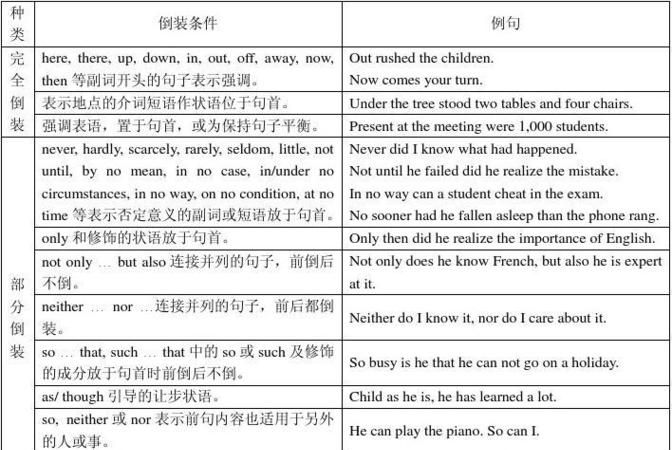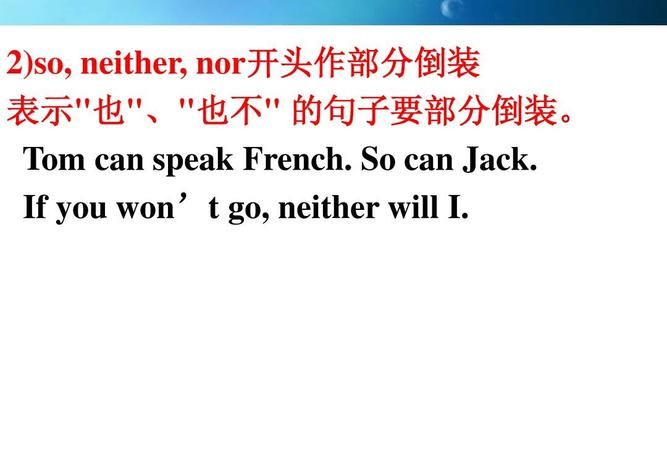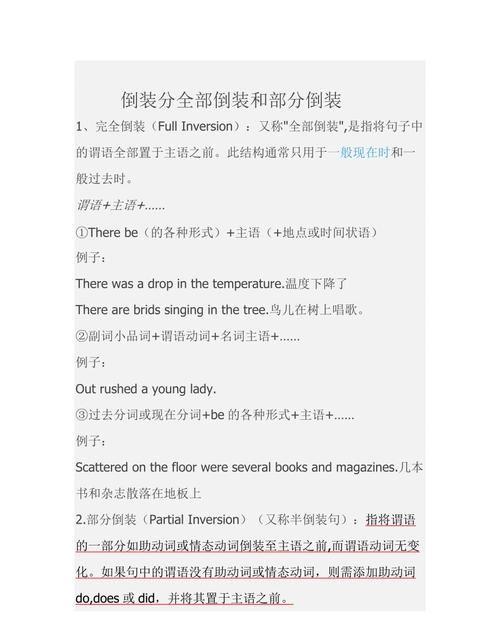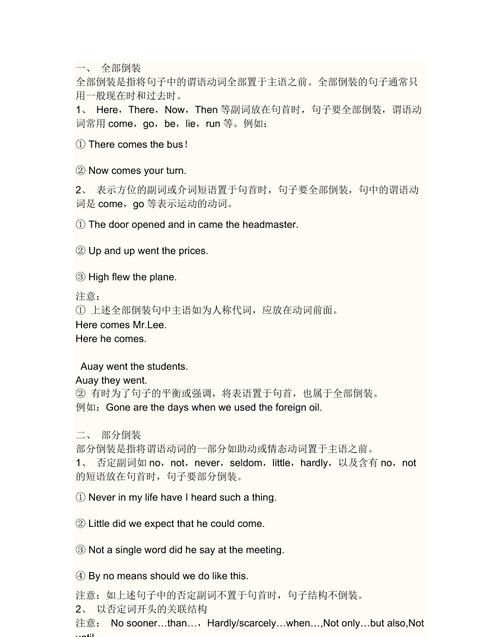本文目录
英语中什么时候用完全倒装
一、 全部倒装
全部倒装是指将句子中的谓语动词全部置于主语之前.全部倒装的句子通常只用一般现在时和过去时.
1、 Here,There,Now,Then等副词放在句首时,句子要全部倒装,谓语动词常用come,go,be,lie,run等.例如:
① There comes the bus!
② Now comes your turn.
2、 表示方位的副词或介词短语置于句首时,句子要全部倒装,句中的谓语动词是come,go等表示运动的动词.
① The door opened and in came the headmaster.
② Up and up went the prices.
③ High flew the plane.
注意:
① 上述全部倒装句中主语如为人称代词,应放在动词前面.
Here comes Mr.Lee.
Here he comes.
Auay went the students.
Auay they went.
② 有时为了句子的平衡或强调,将表语置于句首,也属于全部倒装.
例如:Gone are the days when we used the foreign oil.
二、 部分倒装
部分倒装是指将谓语动词的一部分如助动或情态动词置于主语之前.
1、 否定副词如no,not,never,seldom,little,hardly,以及含有no,not的短语放在句首时,句子要部分倒装.
① Never in my life have I heard such a thing.
② Little did we expect that he could come.
③ Not a single word did he say at the meeting.
④ By no means should we do like this.
注意:如上述句子中的否定副词不置于句首时,句子结构不倒装.
2、 以否定词开头的关联结构
注意:No sooner…than…,Hardly/scarcely…when…,Not only…but also,Not until…
① Not until late in the evening did he come back.
② Hardly had he got on the bus when he heard a shout.
③ Not only did he buy a bike for me but he also sent it to my house.
注意:No sooner…than…;hardly…when;not only…but also这类句型,只将前半部分倒装,后半部分用正常语序.
3、 当only置于句首修饰状语时,句子要部分倒装.
① Only in this way can we learn English well.
② Only when he is seriously ill does he ever stay in bed.
4、 so,neither,nor在句首表示“也”或“也不”句子要部分倒装.
① Tom is very kind.So am I.
② I like English.So does Jack.
③ I can’t speak English.Nor/Neither can he.
注意:so 后主、谓语不倒装表示前面所述内容的肯定、确定.
试比较:
Tom is very kind.So am I.(两个人,一样情形)
Tom is very kind.So he is.(一个人,一种情形)
汤姆非常和蔼.他就是如此.
5、 由as/though引导的让步状语从句,从句形成倒装.
① Child as he was,he could speak five languages.
② Hard as he work,you can’t support your family.
③ Try as you do,you will ever win.
注意:表语为单数名词时,不定冠词“a”应被省去.
She–maker as he was,he was very happy.
6、 so…that/such…that句型中so,such 位于句首时,句子要部分倒装.
① So fast does light travel that it is difficult for us to imagine its speed.
7、 省略了if 的虚拟条件从句中,主谓形成了部分倒装(虚拟语气的条件句中,省略 if 后,had,were,should等应提前)
① Had you told me earlier,I could have done something .
② Should anyone call,tell him to call in the afternoon.
③ Were I you,I would try it again.

英语中倒装句的常见用法有哪些
倒装句作为一种常见的语言现象,尤其被广泛地使用在书面语中,那么你知道如何去使用吗?以下是由我整理关于倒装句的用法的内容,希望大家喜欢!
倒装句的用法
1、主谓倒装。在感叹句或疑问句中,为了强调谓语而将它放到句首,以加强感叹或疑问语气。例:甚矣,汝之不惠。 全句是“汝之不惠甚矣”。谓语前置,表强调的意味,可译为“你太不聪明了”。
2、宾语前置。否定句中代词充当宾语、疑问代词充当动词或介词的宾语以及用“之”字或“是”字作为提宾标志时,宾语通常都要前置。例:“何陋之有”即“有何陋”的倒装。可译为“有什么简陋呢”,“何”,疑问代词,“之”,助词,无实在意义,在这里是宾语前置的标志。
3、定语后置。古汉语中有时为了突出修饰语,将定语放在中心词之后。
例1:遂率子孙荷担者三夫 “荷担者三夫”是“三夫荷担者”的倒装,定语“三夫”后置,以突出中心词“荷担者”,可译为“三个能挑担子的成年男子”。
例2:予谓菊,花之隐逸者也。“花之隐逸者”是“隐逸之花”的倒装。可译为“具有隐逸气质的花”.
例3:尝贻余核舟一,“核舟一”是“一核舟”的倒装,定语“一”后置,可译为“一个核舟”。
4、介宾结构后置。
A、用介词“于”组成的介宾 短语 在文言文中大都后置,译成现代汉语时,除少数译作补语外,大都数都要移到动词前做状语。例:何有于我哉?全句为“于我有何”的倒装句,介宾结构“于我”后置。译为“在我身上有哪一样呢”;“ 告之于帝”是“于帝告之”的倒装,介宾结构“于帝”后置,译为“向天帝 报告 了这件事”;“躬耕于南阳,苟全性命于乱世”,全句为“于南阳躬耕,于乱世苟全性命”的倒装,介宾结构“于南阳、于乱世”后置,可译为“亲自在南阳耕种,在乱世中苟且保全性命”。
B、介词“以”组成的介宾短语后置,在今译时,一般都前置做状语。
例:屠惧,投以骨。全句为“以骨投之”的倒装,介宾结构“以骨”后置。译为“把骨头扔给它”。
为坛而盟,祭以尉首:“祭以尉首”是“以尉首祭”的倒装,介宾结构“以尉首”后置,可译为“用将尉的头来祭祀”。
醉能同其乐,醒能述以文者:“述以文”是“以文述“的倒装,介宾结构”以文“后置,可译为”用文字来记述。
愿陛下托臣以讨贼兴复之效:“托臣以讨贼兴复之效”是“以讨贼兴复之效托臣”的倒装,介宾结构“以讨贼兴复之效“后置。
英语倒装句的用法
一、全部倒装
全部倒装是只将 句子 中的谓语动词全部置于主语之前。此结构通常只用与一般现在时和一般过去时。常见的结构有:
1)here, there, now, then, thus等副词置于句首, 谓语动词常用be, come, go, lie, run.
There goes the bell. 铃响了。
Then came the chairman.主席来了。
Here is your letter. 这是你的新。
2)表示运动方向的副词或地点状语置于句首,谓语表示运动的动词。
Out rushed a missile fromunder the bomber.导弹从轰炸机下面冲了出来。
Ahead sat an old woman.老人坐在前面。
注意:上述全部倒装的句型结构的主语必须是名词,如果主语是人称代词则不能完全倒装。例如:Here he comes. Away they went.
二、部分倒装
部分倒装是指将谓语的一部分如助动词或情态倒装至主语之前。如果句中的谓语没有助动词或情态动词,则需添加助动词do,does或did,并将其置于主语之前。
1)句首为否定或半否定的词语,如no, not, never, seldom, little, hardly, at no time, in no way, not until… 等。
Neverhave I seen such a performance.我从未见过这样的表演。
Nowherewill you find the answer to this question.你找不到这个问题的答案。
Notuntil the child fell asleep did the mother leave the room.直到孩子入睡,母亲才离开
房间。
当Not until引出主从复合句,主句倒装,从句不倒装。
注意: 如否定词不在句首不倒装。
I have never seen such aperformance. 我从未见过这样的表演。
典型例题
1) Why can‘t I smoke here?At no time___ in the meeting-room
A. is smoking permitted B. smoking is permitted
C. smoking is it permitted D. does smoking permit
答案A. 这是一个倒装问题。当否定词语置于句首以表示强调时,其句中的主谓须用倒装结构。 这些否定词包括no, little, hardly,seldom, never, not only,not until等。本题的正常语序是 Smoking is permittedin the meeting-room at no time.
三、以否定词开头作部分倒装
如 Not only…but also, Hardly/Scarcely…when, No sooner… than
Not only did he refuse thegift,he also severelycriticized the sender.他不仅拒绝了礼物,还严厉的批评了送礼的人。
Hardlyhad she gone out when a student came to visit her.她还没走出家门,就有一个学生来看望她。
注意:只有当Not only… but also连接两个分句时,才在第一个分句用倒装结构。如果置于句首的Notonly… but also仅连接两个并列词语,不可用倒装结构。
Not only you but also I amfond of music.不仅是你,还有我,都喜欢音乐。
四、so,neither,nor作部分倒装
表示“也”、“也不” 的句子要部分倒装。
Tom can speak French. So canJack.汤姆会说大于,杰克也会。
五、only在句首要倒装的情况
Only in this way, can you learn English well.只有通过这个 方法 ,你才能将英语学好。
Only after being asked threetimes did he come to the meeting.请了三次,他才来开会
。
如果句子为主从复合句,则主句倒装,从句不倒装
Only when he is seriouslyill, does he ever stay inbed.只有当生病严重的时候,他才躺在床上。
六、as,though 引导的倒装句
as / though引导的让步从句必须将表语或状语提前 (形容词, 副词, 分词, 实义动词提前)。
注意:
1)句首名词不能带任何冠词。
2)句首是实义动词, 其他助动词放在主语后。如果实义动词有宾语和状语,随实义动词一起放在主语之前。
Try hard as he will,he never seems able to dothe work satisfactorily.不管他如何努力,他都不能将这份工作做的让人满意。
看过“英语倒装句的用法”的人还看了:
1. as的倒装句的用法
2. 高考英语倒装句考点讲解
3. 高一英语倒装句语法练习题答案
4. 英语四级写作倒装句技巧讲解
5. 英语中副词的基本用法

英语部分倒装句的用法归纳
在正式文体中,never, seldom, rarely, little, hardly, scarcely, no sooner, no longer, nowhere 等含有否定意义的副词若位于句首,则其后要用部分倒装:
I shall never forgive him. / Never shall I forgive him. 我永远不会宽恕他。
He seldom goes out for dinner. / Seldom does he go out for dinner. 他很少出去吃饭。
She hardly has time to listen to music. / Hardly does she have time to listen to music. 她几乎没时间听音乐。
He little realizes how important this meeting is. / Little does he realize how important this meeting is. 他不甚明白这个会议的重要性。
We had no sooner reached the airport than the plane took off. / No sooner had we reached the airport than the plane took off. 我们刚到机场,飞机就起飞了。
【注意】
(1) 对于not…until句型,当not until…位于句首时,其后的主句要用倒装语序:
He didn’t leave the room until the rain stopped. / Not until the rain stopped did he leave the room. 雨停了之后他才离开这房间。
(2) 某些起副词作用的介词短语,由于含有否定词,若位于句首,其后要用部分倒装:
On no accounts must this switch be touched. 这个开关是绝不能触摸的。
In [Under] no circumstances will I lend money to him.无论如何我也不会再借钱给他了。
但是,in no time(立即,马上)位于句首时,其后无需用倒装语序:
In no time he worked out the problem. 他马上就算出了那道题。
当一个状语受副词only的修饰且置于句首时,其后用部分倒装语序:
Only then did he realize that he was wrong. 到那时他才意识到他错了。
Only in this way are you able to do it well. 你只有用这种方法才能把它做好。
Only when he returned home did he realize what had happened. 当他回到家里时,才知道出了什么事。
副词so后接形容词或副词位于句首时,其后用部分倒装:
So cold was the weather that we had to stay at home. 天气太冷,我们只好呆在家里。
So fast does light travel that we can hardly imagine its speed. 光速很快,我们几乎没法想像它的速度。
So sudden was the attack that we had no time to escape. 袭击来得非常突然,我们来不及逃跑。
当要表示前面提出的某一肯定的情况也同样适合于后者,通常就要用“So+助动词+主语”这种倒装结构:
You are young and so am I. 你年轻,我也年轻。
She likes music and so do I. 她喜欢音乐,我也喜欢。
If he can do it, so can I. 要是他能做此事,我也能。
【注意】
(1) 若前面提出某一否定的情况,要表示后者也属于同样的否定情况,则应将其中的so改为neither或nor:
You aren’t young and neither am I. 你不年轻,我也不年轻。
She hasn’t read it and nor have I. 她没有读它,我也没有读。
(2) 注意该结构与表示强调或同意的“so+主语+特殊动词”结构的区别:
"It was cold yesterday." "So it was." “昨天很冷。”“的确很冷。”
"Father, you promised." "Well, so I did." “爸爸,你答应过的。”“嗯,是答应过。”
当not only…but also位于句首引出句子时,not only 后的句子通常用部分倒装形式:
Not only is he a teacher, but he is also a poet. 他不仅是一位教师,而且是一位诗人。
Not only did he speak more correctly, but he spoke more easily. 不仅他讲得更正确,也讲得更不费劲了。
当if引导的虚拟条件从句中含有had, were, should等时,如将if省略,则要将had, were, should等移到主语前,构成倒装句:
Had you come yesterday, you would have seen him.若你昨天来,你就会见到他了。
Should you require anything give me a ring. 如果需要什么,可以给我打电话。
Were it not for your help, I would still be homeless. 要不是你帮助,我会仍然无家可归。
【注意】省略if后提前的had不一定是助动词:
Had I money, I would buy it. 假若我有钱,我就会买它。
表示地点的here和 there位于句首时,其后用完全倒装形式。这类倒装句的谓语通常是动词be和come, go等表示移动或动态的不及物动词:
Here’s Tom. 汤姆在这里。
There’s Jim. 吉姆在那儿。
Here comes the bus. 公共汽车来了。
There goes the bell. 铃响了。
There goes the last train. 最后一班火车开走了。
【注意】
(1) 以上倒装句中的谓语动词come和go不能用进行时态,即不能说 Here is coming the bus。
(2) 若主语为代词,则不倒装:
Here I am. 我在这儿。/ 我来了。
Here it comes. 它来了。
(3) 其中的动词有时也可能是stand, lie, live等表示状态的动词(表示存在):
There stood a desk against the wall. 靠墙放着一张书桌。
Once upon a time there lived a man known by the name of Beef. 从前有个人名叫比夫。
地点副词away, down, in, off, out, over, round, up 等位于句首时,其后用完全倒装语序。这类倒装句的谓语通常表示动态的不及物动词:
Away went the runners. 赛跑选手们跑远了。
Round and round flew the plane. 飞机盘旋着。
The door opened and in came Mr Smith. 门开了,史密斯先生进了来。
Down came the rain and up went the umbrellas. 下雨了,伞都撑起来了。
【注意】
若主语为人称代词,则不能用倒装:
Away he went. 他跑远了。
Down it came. 它掉了下来。
为了保持句子平衡或使上下文衔接紧密,有时可将状语或表语置于句首,句中主语和谓语完全倒装:
Among these people was his friend Jim. 他的朋友吉姆就在这些人当中。
By the window sat a young man with a magazine in his hand. 窗户边坐着一个年轻人,手里拿着一本杂志。
【注意】
在表语置于句首的这类倒装结构中,要注意其中的谓语应与其后的主语保持一致,而不是与位于句首的表语保持一致。比较:
In the box was a cat. 箱子里是一只猫。
In the box were some cats. 箱子里是一些猫。
有时为了强调,可将谓语部分的现在分词、过去分词或不定式置于句首,从而构成倒装:
Buried in the sands was an ancient village. 一个古老的村庄被埋在这沙土之中。
Standing beside the table was his wife. 站在桌旁的是他的妻子。
To be carefully considered are the following questions. 下列问题要仔细考虑。
按英语习惯同,当“only+状语”位于句首时,其后句子要用部分倒装。如:
Only then did he realize that he was wrong. 到那时他才意识到他错了。
Only in this way are you able to do it well. 你只有用这种方法才能把它做好。
Only in this way can our honour be saved. 只有这样,才能保住我们的荣誉。
Only then did I understand what she meant. 只有到那时我才明白她的意思。
Only after her death was I able to appreciate her. 只有到她死后我才认识到她的价值。
Only when he returned home did he realize what had happened. 当他回到家里时,才知道出了什么事。
Only in this way can we learn English. 只有这样才能学会英语。
The pilot reassured the passengers. Only then did I realize how dangerous the situation had been. 飞机驾驶员要乘客们放心,这时我才明白刚才的情况有多危险。
Only by shouting was he able to make himself heard. 他只有叫喊才能让别人听到他。
Only when we landed did we see how badly the plane had been damaged. 我们只是在着陆之后才看到飞机损坏的严重程度。
Only on one point do I agree with you. 只有一点,我同意你的说法。
1. Only then _________ how much damage had been caused.
A. she realized B. she had realized
C. had she realized D. did she realize
2. Only after my friend came _________.
A. did the computer repaired B. be repaired the computer
C. was the computer repaired D. the computer was repaired
特别说明:有时命题者不是利用位于句首的“only+状语”来考查倒装,而是倒过来,利用给定的倒装结构来考查对only的选择。如下面一题(答案选A):
_________ by keeping down costs will Power Data hold its advantage over other companies.
A. Only B. Just C. Still D. Yet
So cold was the weather that we had to stay at home. 天气太冷,我们只好呆在家里。
So fast does light travel that we can hardly imagine its speed. 光速很快,我们几乎没法想象它的速度。
So sudden was the attack that we had no time to escape. 袭击来得非常突然,我们来不及逃跑。
You are young and so am I. 你年轻,我也年轻。
She likes music and so do I. 她喜欢音乐,我也喜欢。
If he can do it, so can I. 要是他能做此事,我也能。
1. So difficult _________ it to work out the problem that I decided to ask Tom for advice.
A. I did find B. did I find C. I have found D. have I found
2. _________ about wild plants that they decided to make a trip to Madagascar for further research.
A. so curious the couple was B. So curious were the couple
C. How curious the couple were D. The couple was such curious
3. —It’s burning hot today, isn’t it?—Yes. _________ yesterday.
A. So was it B. So it was C. So it is D. So is it
特别说明:
(1) 若前面提出某一否定的情况,要表示后者也属于同样的否定情况,则应将其中的so改为neither或nor。如:
You aren’t young and neither am I. 你不年轻,我也不年轻。
She hasn’t read it and nor have I. 她没有读它,我也没有读。
请看考题(答案选D):
Mary never does any reading in the evening, _________.
A. so does John B. John does too
C. John doesn’t too D. nor does John
(2) 注意“So+助动词+主语”与表示强调或同意的“So+主语+助动词”的区别。如:
“It was cold yesterday.” “So it was.” “昨天很冷。”“的确很冷。”
请看考题(答案分别为CD):
1. — Maggie had a wonderful time at the party. —_________, and so did I.
A. So she had B. So had she C. So she did D. So did she
2.—Father, you promised! —Well, _________. But it was you who didn’t keep your word first.
A. so was I B. so did I C. so I was D. so I did
在“副词here, there, now, then, up, down, in, out, away等、作状语或表语的介词短语或分词短语+谓语动词+主语”的倒装结构中,谓语动词的数由动词后面的主语决定。如:
On the wall hang two maps. 墙上挂着两张地图。
On the wall hangs a world of map. 墙上挂着一张世界地图。
Here is your coat. 这是你的外套。
Here are your running-shoes. 这是你的跑鞋。
Such is the result. 结果就是这样。
Such are the results. 这就是结果。
here 和 there 之后以及诸如 back, down, off, up 等一类的副词小品词之后,名词主语一般置于谓语之后。这类副词常与诸如 come 和 go 等转移动词一起连用。如:
Here comes a taxi! There goes the last train! 有辆出租车来了! 最后一班火车开走了! (注意这里不可用进行时)
Down came the rain and up went the umbrellas. 下雨了,伞都撑了起来。
当我们给人东西或确定位置时,这种倒装常用在be之后(主语往往是复数)。如:
Here’s a cup of tea for you. 给你一杯茶。(给东西)
Here’s your letters. 这儿有你的信。(给与或指明)
There’s (重读) Johnny smith. 约翰尼·史密斯在那儿。(确定位置)
主语如是代词则不倒装。如:
Here it comes. 它来了。
There she goes. 她走了。
Up it went. 它上去了。
Here you are. 给你。
There she is. 她在那儿。
地点状语后面如有表示位置的动词 (如lie, live, sit, stand) 或转移的动词 (如come, go, rise),用作主语的名词可以放在动词之后。这种情形主要出现在描写文中。如:
At the top of the hill stood the tiny chapel. 那座小教堂矗立在山顶上。
In the fields of poppies lay the dying soldiers. 罂粟地里躺着奄奄一息的士兵们。
别的动词如属被动语态也可以倒装。
In the distance could be seen the purple mountains. 远处可以见到紫色的山。
主语如是代词则不能倒装:
At the top of the hill it stood out against the sky. 它背衬青天矗立在山顶上。
否定或近似否定副词(往往是时间或频度副词,如never, rarely, seldom),或是具有否定作用的副词,如 little, on no account 等。如:
Never / Seldom has there been so much protest against the Bomb. 这么强烈的反对原子弹的抗议活动从未 / 很少 / 有过。
Little does he realize how important this meeting is. 他对这个会议的重要性不甚了了。
On no account must you accept any money if he offers it. 他如要给你钱,你可绝不能接受。
当这种副词不在句首时,当然应该用正常词序:
There has never / seldom been so much protest against the Bomb. 从未 / 很少发生过这么强烈的反对原子弹的抗议活动。
He little realizes how important this meeting is. 他不甚明白这个会议的重要性。
另外,有些含有否定意义的介词短语置于句首时,其后也要用倒装。如:
In no case should you give up. 你绝不能放弃。
On no condition should we tell her about it. 我们绝不能把此事告诉她。
On no accounts must this switch be touched.这个开关是绝 不能触摸的。
In [Under] no circumstances will I lend money to him.无论如何我也不会再借钱给他了。
Under no circumstances should you lend him any money. 你无论如何都不该把钱借给他。
No way will I go on working for that man. 我不再给那个人工作了。
not only…but also…前后连接两个句子时,not only后的句子要用部分倒装,但but also后的分句不用倒装。如:
Not only did he come, but he saw her. 他不仅来了,而且还见到了她。
Not only does she speak Spanish, (but) she also knows how to type. 她不但会说西班牙语,还会打字呢。
Not only is he a teacher, but he is also a poet. 他不仅是一位教师,而且是一位诗人。
Not only did he speak more correctly, but he spoke more easily. 不仅他讲得更正确,也讲得更不费劲了。
Not only did they present a musical performance, but they also gave a brief introduction to the history of Western brass instruments. 他们不但做了音乐表演,而且简短地介绍了西方铜管乐器的历史。
so / neither / nor表示前面所说的情况也适合于后者时,其句型是:so / neither / nor+特殊词+主语。使句此句型需注意以下几点:①内容是肯定时,用so,内容是否定时,用neither或nor;②“特殊词”与前句中的情态动词、助动词或be相同,或根据前句的时态,用do, does, did;③“特殊词”的人称和数与其后的主语一致;④“特殊词”本身没有否定形式。如:
You are young and so am I. 你年轻,我也年轻。
She likes music and so do I. 她喜欢音乐,我也喜欢。
If he can do it, so can I. 要是他能做此事,我也能。
You aren’t young and neither am I. 你不年轻,我也不年轻。
She hasn’t read it and nor have I. 她没有读它,我也没有读。
在so... that…结构中,若将so+adj. / adv. 置于句首,则其后的主句要用部分倒装。如:
So cold was the weather that we had to stay at home. 天气太冷,我们只好呆在家里。
So much did they eat that they could not move for the next hour. 他们吃得太多了,一个小时都动弹不得。
So loudly did he speak that even people in the next room could hear him. 他讲话声音那么大,隔壁屋里的人都听得见。
So fast does light travel that we can hardly imagine its speed. 光速很快,我们几乎没法像它的速度。
So sudden was the attack that we had no time to escape. 袭击来得非常突然,我们来不及逃跑。
类似地,当such…that…结构的such…置于句首时,such后的句子也要使用部分倒装。如:
Such a nice man did he seem that we all believe him. 他像个很和蔼的人,所以我们都喜欢他。
有时为了强调或者为了使句子平衡或者为了使上下文连接得更加紧密,就将表语和地点状语(多为介词短语)置于句首,谓语动词也常置于主语前,构成完全倒装。如:
By the door stood an armed guard. 门口站着一名手持武器的士兵。
At the next table was a pretty girl waiting for someone. 隔壁桌上坐着一个等人的漂亮姑娘。
Among these people was his friend Jim. 他的朋友吉姆就在这些人当中。
By the window sat a young man with a magazine in his hand. 窗户边坐着一个年轻人,手里拿着一本杂志。
At the front of the book is a table of contents, giving details of what is in the book. 书的前部有目录,详列了书中的内容。
as作“虽然”解,引导让步状语从句时,必须将表语、状语或动词原形提到as前面。此时应注意几点:一是若提前的表语是没有形容词修饰的单数可数名词,要省略不定冠词;二是若提前的是动词原形(多为不及物动词),与之连用的通常是may, might, will, would等,且这些词都要保留在原来的位置上(主语后);三是though有时也可像as这样使作倒装。如:
Tired as I was, I tried to help them. 虽然我很累,我还是努力帮助他们。
Try as he would, he couldn’t open the door. 他试过多次了, 却仍打不开那门。
Search as they would, they would find nobody in the house. 无论怎样搜查,他们在房子里仍然没有找到一个人。
Hard as (though) they tried, they couldn’t make her change her mind. 尽管他们做了很大努力,却没法让她改变主意。
Boy as he was, he behaved like a girl. 他虽是个男孩,但举止却像个女孩。
有时为了强调,可将谓语部分的现在分词、过去分词或不定式置于句首,从而构成倒装。如:
Buried in the sands was an ancient village. 一个古老的村庄被埋在这沙土之中。
Standing beside the table was his wife. 站在桌旁的是他的妻子。
To be carefully considered are the following questions. 下列问题要仔细考虑。

英语中的完全倒装和部分倒装分别是什么?
一、部分倒装 将谓语中的助动词或情态动词置于主语之前,就是部分倒装.部分倒装通常出现在以下场合:\x0d2.“ only + 状语 / 状语从句”位于句首时,句子的主语或主句中的主语和谓语要部分倒装.例如:Only yesterday afternoon did I finish my experiment.\x0d3.表示否定意义的副词或连词放在句首时,主语和谓语要部分倒装.例如:Never shall I do the same thing again.Not until all the fish died in the river did the villagers realize how serious the pollution was.\x0d4.在含有 had ,were ,should 的虚拟条件句中,可以省略 if ,将 had ,were ,should 放在主语之前,构成部分倒装.例如:Had you come here,you would have met the film star.Were I you,I would take the money.Should any one come to set me free,I would make him very rich.\x0d5.在 so … that …句式中,如果 so 引导的部分前置,主句中的主语和谓语需用部分倒装.例如:So carelessly did he drive that he almost killed himself.\x0d6.当 so,neither,nor 位于句首时,可将其后与上面重复的谓语的一部分置于主语之前,构成部分倒装.例如:— He has been to Beijing.— So have I.— Liu Jia can't answer the question.— Neither/Nor can Lai Fan.说明:1 ) so 位于句首时,具备三个条件才可以将主语和谓语部分倒装:① so 表示“也”的意思;②上句是简单句的肯定句;③上句的主语和 so 引导的句子主语不同.如果 so 所在的分句的主语与上句的主语相同,这时 so 的意思是“的确”,so 分句中的主、谓语无须倒装.例如:— Jenny has decided to turn in the wallet.— So she has.2 )上面的句子有两个或两个以上的分句,而且这些分句中的谓语动词又不属于同一类型,但它们所陈述的情况也适合另一个人或物时,常用的结构为:So it is/was with … 例如:— Li Juan is a pretty girl and she studies in No.1 Middle School of Enshi.— So it is with Meng Lu.\x0d二、完全倒装 将整个谓语部分置于主语之前即为完全倒装.这种完全倒装的语序出现在下列场合:\x0d1.away ,down ,up ,in ,out 等副词位于句首且主语为名词时,可将 come ,go 等表示位置转移的动词放在主语之前;但主语为代词时,主语和谓语不倒装.例如:The door opened and in came the teacher.Down he sat by the table.\x0d2.here 和 there 位于句首,且主语为名词时,可将主语和谓语全部倒装.例如:Here is your rice.There goes the bell.\x0d3.当句首的表语或状语是表示地点的介词短语时,句子中的主语和谓语要全部倒装.例如:On the front wall is a blackboard.On the back wall hangs a map of China.\x0d4.有时为了使上下文紧密衔接,也要用完全倒装.例如:They arrived at a farmhouse,in front of which sat a small boy.\x0d5.直接引语前置,引导语中的主语是名词时,主语、谓语通常要完全倒装.

以上就是关于英语中部分倒装的用法,英语中什么时候用完全倒装的全部内容,以及英语中部分倒装的用法 的相关内容,希望能够帮到您。

